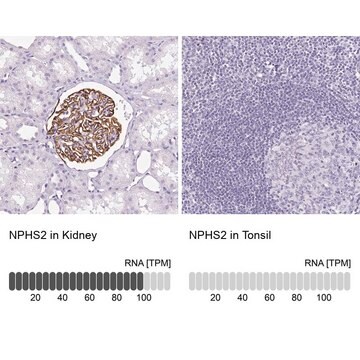MABN2729
Anti-Islet-1 homeobox Antibody, clone 40.2D6
Synonym(s):
Insulin gene enhancer protein ISL-1
About This Item
Recommended Products
biological source
mouse
Quality Level
antibody form
purified antibody
antibody product type
primary antibodies
clone
40.2D6, monoclonal
mol wt
calculated mol wt 39.04 kDa
purified by
using protein G
species reactivity
frog, rhesus macaque, zebrafish, human, mouse, rat, guinea pig, canine
packaging
antibody small pack of 100
technique(s)
ChIP: suitable
electron microscopy: suitable
flow cytometry: suitable
immunocytochemistry: suitable
immunofluorescence: suitable
immunohistochemistry: suitable
immunoprecipitation (IP): suitable
western blot: suitable
isotype
IgG1κ
epitope sequence
C-terminal half
Protein ID accession no.
UniProt accession no.
storage temp.
2-8°C
Gene Information
rat ... Isl1(64444)
Specificity
Immunogen
Application
Evaluated by Immunohistochemistry (Paraffin) in Human pancreas tissue sections.
Immunohistochemistry (Paraffin) Analysis: A 1:50 dilution of this antibody detected Islet-1 homeobox protein in Human pancreas tissue sections.
Tested Applications
Immunohistochemistry Applications: A representative lot detected Islet-1 homeobox in Immunohistochemistry applications (Hoeber, J., et al. (2015). Sci Rep. 5:10666; Fischer, A.J., et al. (2010). PLoS One. 5(6):e10774; Schick, E., et al. (2019). Sci Rep. 9(1):9358; Ediger, B.N., et al. (2014). Diabetes. 63(12):4206-17; Wan, Y., et al. (2019). Cell. 179(2):355-372.e23).
Immunocytochemistry Analysis: A representative lot detected Islet-1 homeobox in Immunocytochemistry applications (Vahsen, B.F., et al. (2022). Sci Rep. 12(1):12606; Hoeber, J., et al. (2015). Sci Rep. 5:10666).
Immunohistochemistry (Paraffin) Analysis: A representative lot detected Islet-1 homeobox in Immunohistochemistry applications (Du, A., et al. (2009). Diabetes. 58(9):2059-69; Ediger, B.N., et al. (2014). Diabetes. 63(12):4206-17).
Chromatin Immunoprecipitation Analysis (ChIP): A representative lot detected Islet-1 homeobox in Chromatin Immunoprecipitation applications (Du, A., et al. (2009). Diabetes.58(9):2059-69).
Immunoprecipitation Analysis: A representative lot immunoprecipitated Islet-1 homeobox in Immunoprecipitation applications (Velasco, S., et al. (2017). Cell Stem Cell. 20(2):205-217).
Western Blotting Analysis: A representative lot detected Islet-1 homeobox in Western Blotting applications (Haremaki, T., et al. (2010). Dev Dyn. 239(7):1977-87).
Electrophoretic Mobility Shift Assay (EMSA): A representative lot detected Islet-1 homeobox in Electrophoretic Mobility Shift Assay applications (Ediger, B.N., et al. (2014). Diabetes. 63(12):4206-17).
Flow Cytometry Analysis: A representative lot detected Islet-1 homeobox in Flow Cytometry applications (Meng, X., et al. (2020). Genes (Basel). 11(3):328).
Immunofluorescence Analysis: A representative lot detected Islet-1 homeobox in Immunofluorescence applications (Vahsen, B.F., et al. (2022). Sci Rep. 12(1):12606; Hoeber, J., et al. (2015). Sci Rep. 5:10666; Du, A., et al. (2009). Diabetes. 58(9):2059-69; Ediger, B.N., et al. (2014). Diabetes. 63(12):4206-17).
Note: Actual optimal working dilutions must be determined by end user as specimens, and experimental conditions may vary with the end user.
Target description
Physical form
Reconstitution
Storage and Stability
Other Notes
Disclaimer
Not finding the right product?
Try our Product Selector Tool.
Storage Class Code
12 - Non Combustible Liquids
WGK
WGK 1
Flash Point(F)
Not applicable
Flash Point(C)
Not applicable
Certificates of Analysis (COA)
Search for Certificates of Analysis (COA) by entering the products Lot/Batch Number. Lot and Batch Numbers can be found on a product’s label following the words ‘Lot’ or ‘Batch’.
Already Own This Product?
Find documentation for the products that you have recently purchased in the Document Library.
Our team of scientists has experience in all areas of research including Life Science, Material Science, Chemical Synthesis, Chromatography, Analytical and many others.
Contact Technical Service